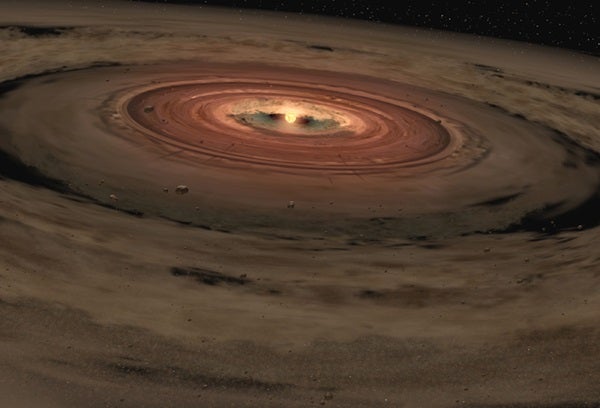The smallest known pulsar planet, diamond layers inside carbon planets, and a star almost as small as a planet were among the discoveries reported in early February at an Aspen, Colorado, conference on planet formation and detection.
Extrasolar planets may contain substantial amounts of carbon compounds, says astrophysicist Marc Kuchner of Princeton University. And if they do, he says, they would likely have a layer of diamond inside. He notes that the planet’s natural heat and pressure would squeeze carbon into diamond.
“Carbon planets could form much like carbonaceous chondrite meteorites do in our solar system,” say Kuchner and colleague Sara Seager of the Carnegie Institution of Washington. Carbonaceous chondrites are meteorites rich in carbon compounds such as carbides, graphite, and even tiny diamonds, say the researchers.
Carbon planets would form in protoplanetary disks wherever oxygen was scarce, notes Kuchner. He adds such planets could survive closer to a star than planets built of silicates such as Earth. The reason is that carbides, a form of ceramic, have higher melting points than the silicates that make up terrestrial planets.
A micro-star has been found with the makings of a mini-solar system, says a team of Spitzer Space Telescope astronomers. The star, a brown dwarf named OTS 44, has the mass of about 15 Jupiters. It is surrounded by a dusty disk that appears to be still in the early stages of making planets.
“There may be a host of miniature solar systems with planets orbiting brown dwarfs,” says Kevin Luhman of the Harvard-Smithsonian Center for Astrophysics, the head of a team of astronomers who made the discovery, due for publication in The Astrophysical Journal Letters. He notes the finding suggests that perhaps many other brown dwarf stars also have disks.
OTS 44 lies about 500 light-years away in the southern constellation Chamaeleon. Astronomers speculate the brown dwarf’s disk has enough material to make one gas-giant planet and a handful of Earth-size ones.
The pulsar B1257+12 was the first object outside the solar system discovered to have a planet orbiting it, in 1992. The discoverer, Alex Wolszczan of Pennsylvania State University, eventually identified three terrestrial-size planets orbiting the pulsar.
Now, along with colleague Maciej Konacki of Caltech, Wolszczan says there’s a fourth planet in the system. It orbits farthest from the pulsar and has a mass only 20 percent that of Pluto, or about 4 percent the mass of Earth’s Moon. Wolszczan and Konacki discovered the new planet by tracking periodic changes in the star’s pulses, the same technique that uncovered the other planets in the system.
“Our observations also rule out the idea of any more planets as big as these,” adds Wolszczan.
This pulsar-planet system had already surprised astronomers because the three previously known planets have orbits spaced almost exactly proportional to the spacing of Mercury, Venus, and Earth in our solar system. The new body, dubbed Planet D, orbits 6 times farther than the third planet. In all, the pulsar-planet system partly resembles a half-size model of the solar system.
Pulsar planets are not primordial, say astronomers. That is, they did not form when the star that became a pulsar did. Instead, says Wolszczan, the existence of these planets indicates the system probably had a second star in orbit originally. At some point, this companion was torn apart by the star that became a pulsar. The pulsar planets then formed out of the companion star’s debris.










